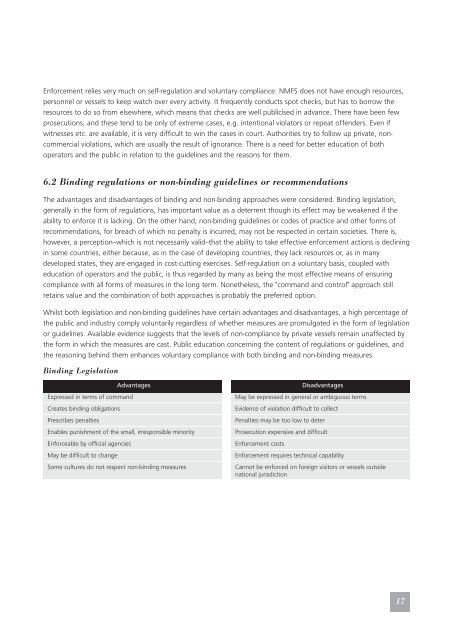leagal aspects of the whale watching.pdf - International Fund for ...
leagal aspects of the whale watching.pdf - International Fund for ...
leagal aspects of the whale watching.pdf - International Fund for ...
You also want an ePaper? Increase the reach of your titles
YUMPU automatically turns print PDFs into web optimized ePapers that Google loves.
En<strong>for</strong>cement relies very much on self-regulation and voluntary compliance. NMFS does not have enough resources,<br />
personnel or vessels to keep watch over every activity. It frequently conducts spot checks, but has to borrow <strong>the</strong><br />
resources to do so from elsewhere, which means that checks are well publicised in advance. There have been few<br />
prosecutions, and <strong>the</strong>se tend to be only <strong>of</strong> extreme cases, e.g. intentional violators or repeat <strong>of</strong>fenders. Even if<br />
witnesses etc. are available, it is very difficult to win <strong>the</strong> cases in court. Authorities try to follow up private, noncommercial<br />
violations, which are usually <strong>the</strong> result <strong>of</strong> ignorance. There is a need <strong>for</strong> better education <strong>of</strong> both<br />
operators and <strong>the</strong> public in relation to <strong>the</strong> guidelines and <strong>the</strong> reasons <strong>for</strong> <strong>the</strong>m.<br />
6.2 Binding regulations or non-binding guidelines or recommendations<br />
The advantages and disadvantages <strong>of</strong> binding and non-binding approaches were considered. Binding legislation,<br />
generally in <strong>the</strong> <strong>for</strong>m <strong>of</strong> regulations, has important value as a deterrent though its effect may be weakened if <strong>the</strong><br />
ability to en<strong>for</strong>ce it is lacking. On <strong>the</strong> o<strong>the</strong>r hand, non-binding guidelines or codes <strong>of</strong> practice and o<strong>the</strong>r <strong>for</strong>ms <strong>of</strong><br />
recommendations, <strong>for</strong> breach <strong>of</strong> which no penalty is incurred, may not be respected in certain societies. There is,<br />
however, a perception--which is not necessarily valid--that <strong>the</strong> ability to take effective en<strong>for</strong>cement actions is declining<br />
in some countries, ei<strong>the</strong>r because, as in <strong>the</strong> case <strong>of</strong> developing countries, <strong>the</strong>y lack resources or, as in many<br />
developed states, <strong>the</strong>y are engaged in cost-cutting exercises. Self-regulation on a voluntary basis, coupled with<br />
education <strong>of</strong> operators and <strong>the</strong> public, is thus regarded by many as being <strong>the</strong> most effective means <strong>of</strong> ensuring<br />
compliance with all <strong>for</strong>ms <strong>of</strong> measures in <strong>the</strong> long term. None<strong>the</strong>less, <strong>the</strong> "command and control" approach still<br />
retains value and <strong>the</strong> combination <strong>of</strong> both approaches is probably <strong>the</strong> preferred option.<br />
Whilst both legislation and non-binding guidelines have certain advantages and disadvantages, a high percentage <strong>of</strong><br />
<strong>the</strong> public and industry comply voluntarily regardless <strong>of</strong> whe<strong>the</strong>r measures are promulgated in <strong>the</strong> <strong>for</strong>m <strong>of</strong> legislation<br />
or guidelines. Available evidence suggests that <strong>the</strong> levels <strong>of</strong> non-compliance by private vessels remain unaffected by<br />
<strong>the</strong> <strong>for</strong>m in which <strong>the</strong> measures are cast. Public education concerning <strong>the</strong> content <strong>of</strong> regulations or guidelines, and<br />
<strong>the</strong> reasoning behind <strong>the</strong>m enhances voluntary compliance with both binding and non-binding measures.<br />
Binding Legislation<br />
Advantages Disadvantages<br />
Expressed in terms <strong>of</strong> command May be expressed in general or ambiguous terms<br />
Creates binding obligations Evidence <strong>of</strong> violation difficult to collect<br />
Prescribes penalties Penalties may be too low to deter<br />
Enables punishment <strong>of</strong> <strong>the</strong> small, irresponsible minority Prosecution expensive and difficult<br />
En<strong>for</strong>ceable by <strong>of</strong>ficial agencies En<strong>for</strong>cement costs<br />
May be difficult to change En<strong>for</strong>cement requires technical capability<br />
Some cultures do not respect non-binding measures Cannot be en<strong>for</strong>ced on <strong>for</strong>eign visitors or vessels outside<br />
national jurisdiction<br />
17
















